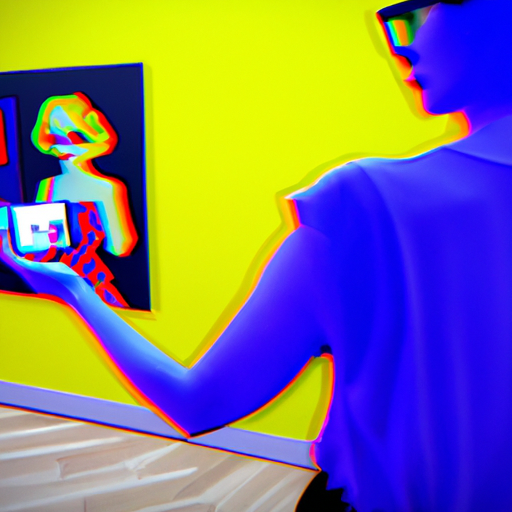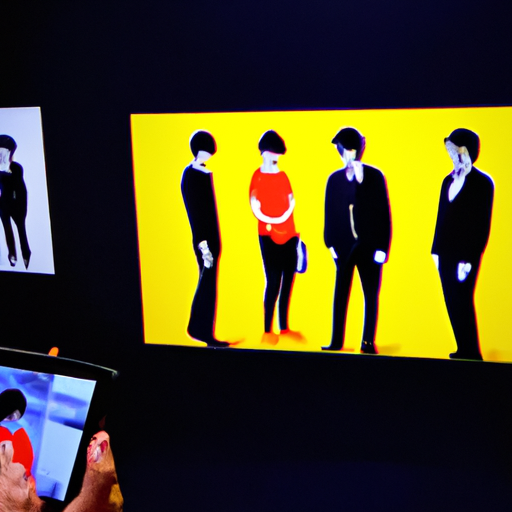
-
Table of Contents
- Augmented Reality in Art Exhibitions and Graphic Design
- The Rise of Augmented Reality in Art
- Enhancing Artistic Expression with AR
- Engaging Audiences through Interactive Experiences
- Challenges and Limitations of AR in Art Exhibitions and Graphic Design
- The Future of Augmented Reality in Art and Design
- Conclusion
Augmented Reality in Art Exhibitions and Graphic Design

Augmented reality (AR) has emerged as a powerful tool in the world of art exhibitions and graphic design. By blending the physical and digital realms, AR enhances the viewer’s experience, allowing them to interact with art in new and exciting ways. This article explores the impact of augmented reality on art exhibitions and graphic design, highlighting its benefits, challenges, and potential future developments.
The Rise of Augmented Reality in Art
Augmented reality has gained significant traction in recent years, transforming various industries, including art and design. AR technology overlays digital content onto the real world, creating an immersive and interactive experience for users. In the context of art exhibitions and graphic design, AR offers artists and designers a unique platform to showcase their work and engage with audiences on a deeper level.
One notable example of AR in art exhibitions is the “Rain Room” installation by Random International. This interactive artwork allows visitors to walk through a simulated rainstorm without getting wet. Using motion sensors and AR technology, the rain stops wherever the visitor walks, creating a mesmerizing and immersive experience. The “Rain Room” has been exhibited in renowned museums worldwide, captivating audiences and redefining the boundaries of traditional art exhibitions.
Enhancing Artistic Expression with AR
Augmented reality opens up new possibilities for artists to express their creativity and push the boundaries of traditional art forms. By integrating digital elements into their work, artists can create dynamic and interactive pieces that captivate and engage viewers.
For example, the artist Olafur Eliasson has incorporated AR into his installations to explore themes of perception and reality. In his artwork “Your Rainbow Panorama,” Eliasson created a circular walkway with colored glass panels that filter the surrounding landscape. By using an AR app, visitors can see the world through different colored filters, altering their perception of reality and challenging their understanding of space and color.
AR also allows artists to experiment with new mediums and techniques. With the help of AR tools, artists can create virtual sculptures, 3D paintings, and animated artworks that come to life when viewed through a smartphone or tablet. This fusion of traditional and digital art forms not only enhances the visual experience but also encourages audience participation and exploration.
Engaging Audiences through Interactive Experiences
One of the key advantages of augmented reality in art exhibitions and graphic design is its ability to engage audiences through interactive experiences. AR technology enables viewers to actively participate in the artwork, blurring the line between observer and creator.
For instance, the Museum of Modern Art (MoMA) in New York City introduced an AR app called “MoMAR Gallery” that overlays digital artworks onto the physical gallery space. Visitors can use their smartphones to view and interact with these virtual artworks, adding an extra layer of engagement to their museum experience. This innovative use of AR not only attracts younger audiences but also encourages them to explore and appreciate art in a new and interactive way.
Similarly, graphic designers have embraced augmented reality to create interactive and immersive experiences for their clients. By incorporating AR elements into print materials such as brochures or packaging, designers can provide additional information, animations, or even games to engage consumers. This not only enhances the user experience but also helps brands stand out in a crowded marketplace.
Challenges and Limitations of AR in Art Exhibitions and Graphic Design
While augmented reality offers exciting opportunities for art exhibitions and graphic design, it also presents challenges and limitations that need to be addressed.
One of the main challenges is the accessibility of AR experiences. While smartphones and tablets have become ubiquitous, not all users have access to these devices or the necessary apps to view AR content. This can limit the reach and impact of AR artworks and designs, particularly in less technologically advanced regions or among older demographics.
Another challenge is the integration of AR into physical spaces. Art exhibitions and galleries often have specific lighting, spatial, and aesthetic requirements that may not align with the technical requirements of AR. Ensuring a seamless integration of AR technology into physical spaces without compromising the artistic vision can be a complex task for artists and curators.
Furthermore, the rapid pace of technological advancements poses a challenge for artists and designers working with AR. As new AR tools and platforms emerge, artists need to continuously adapt and learn new skills to stay relevant. This can be time-consuming and may require additional resources and training.
The Future of Augmented Reality in Art and Design
Despite the challenges, the future of augmented reality in art exhibitions and graphic design looks promising. As technology continues to evolve, AR experiences are becoming more accessible and user-friendly. The increasing affordability of AR devices and the development of web-based AR platforms are making it easier for artists and designers to create and share their work with a wider audience.
Moreover, advancements in AR hardware, such as smart glasses and contact lenses, hold the potential to revolutionize the way we experience art. These wearable devices can provide a more seamless and immersive AR experience, eliminating the need for handheld devices and further blurring the boundaries between the physical and digital worlds.
Additionally, the integration of artificial intelligence (AI) with AR opens up new possibilities for personalized and adaptive art experiences. AI algorithms can analyze user preferences and behaviors to create customized AR artworks or designs tailored to individual viewers. This level of personalization can enhance audience engagement and create more meaningful connections between the artwork and the viewer.
Conclusion
Augmented reality has transformed the art exhibition and graphic design landscape, offering new ways for artists and designers to express their creativity and engage with audiences. By blending the physical and digital realms, AR enhances the viewer’s experience, enabling interactive and immersive encounters with art. While challenges and limitations exist, the future of augmented reality in art and design looks promising, with advancements in technology and accessibility opening up new possibilities for artists and audiences alike.
